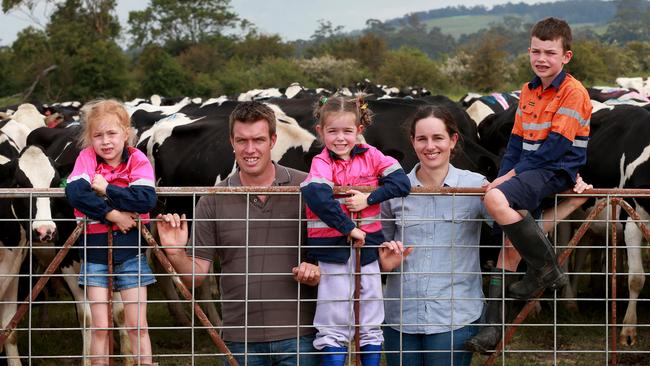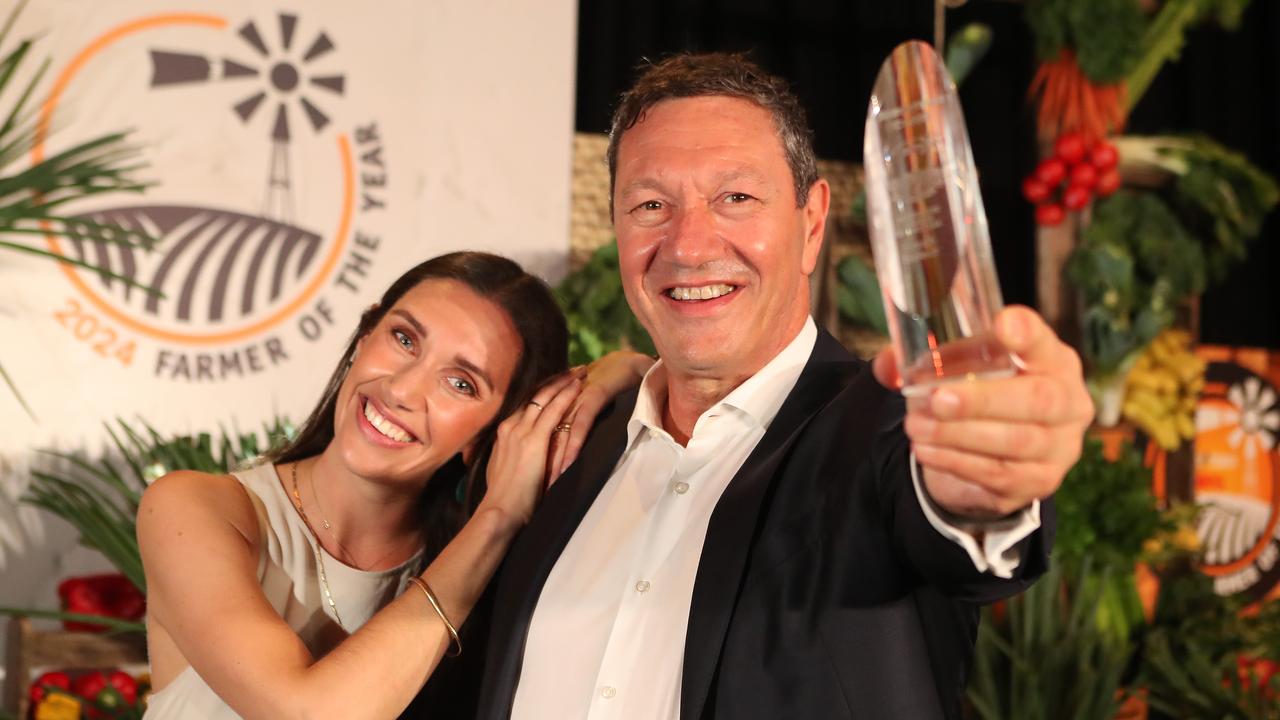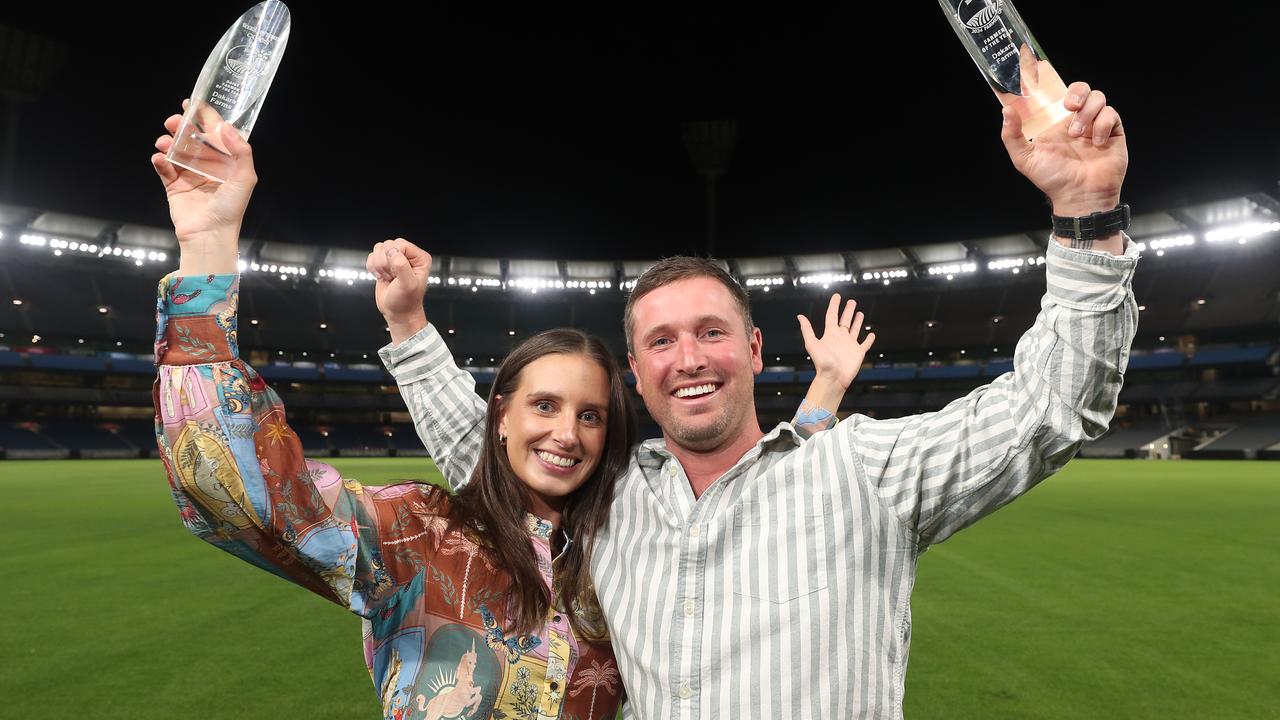Dairy farming: Simon and Lauren Finger of Darnum milk the opportunities
WHEN opportunity knocks, Simon and Lauren Finger have an open-door policy, writes SIMONE SMITH.

WHEN talking to Simon and Lauren Finger, the word opportunity comes up regularly in the conversation.
They took an opportunity to take on a lease farm at Darnum in West Gippsland three years ago, another to buy 280 crossbred heifers on the point of joining for $500 to stock it. These are among several examples.
Ask them whether it was about creating or taking the opportunities and they reply, “A bit of both.”
And although they take opportunities as they arise, they explain with a laugh, “It’s not always the right opportunities … maybe.”
“We’ve been probably willing to look maybe wider and further than some (other people) for opportunities,” Lauren said.
“Some of it is also about looking at maintaining relationships that create opportunities as well.”
Simon and Lauren milk about 700 cows across three farms, two leased and a home farm, and want to increase that to 1000. Each farm is milking once a day.
It’s a system that makes labour management easier, is great for cow welfare, slashes running costs — such as electricity — and also has lifestyle benefits. It also allows them to come out within $10,000 of their twice-a-day budgets, “as good as even” and with lower risk.
While once-a-day milking has suited their business and let them expand into different regions with different soil types, seasonality and climate, they are not wedded to the idea.
Lauren said there’s “a limit to how much you can feed a once-a-day cow” and shifting to twice a day would help increase production if it weren’t possible to lift the stocking rate through buying cows.
Simon said their business was flexible and they were “margin farmers rather than dairy farmers”, chasing the business margin or opportunity.
“We take opportunities and add that to our business to meet the market signals and the climate,” Simon said.
ACTION STATIONS
THE couple have managers on each of the other two farms, at Labertouche and Darnum. Like the Yannathan home farm, Labertouche runs a spring calving herd while Darnum is autumn calving.
The entire operation runs with two fulltime employees, one part-time at Yannathan on top of Lauren and Simon, as well as two casuals.
They estimate anther five people would be needed if they milked twice a day. But on the flip side, once-a-day milking has allowed them to expand to double their stock numbers without adding staff.
All the farms have a rye-grass pasture base and the cows do not exceed 4-4.5kg of grain in the dairy each day because of fears of acidosis.
Rumen protection is critical, but so is ensuring quality feed is kept up, especially in early to mid-lactation. Quality silage makes up feed shortfalls early in the diet for the autumn-calving Darnum herd.
The recent silage harvest at Yannathan was expected to produce more than 10 megajoules/kg of metabolisable energy and a protein percentage in the “low to mid 20s”.
Pasture allocation depends on the stocking rate, but Simon said a once-a-day system provided just one opportunity a day to get the allocation right.
Low stress stock handling comes into play as a way to manage the bulk milk cell count, something that needs careful attention, especially on a once-a-day system.
“We feel cow stress in the dairy is probably worth around 60,000-70,000 cells/ml on the cell count,” Lauren said.
Running at an average of 80,000 cells/ml milking twice a day, Lauren said getting simple and effective practices in place helped them manage this on the once-a-day system.
They use teat seal, cull chronically infected cows and ensure the environment allows good milk let down.
BULL’S ROAR
WHEN it comes to joining cows on the once-a-day system, the Fingers said it was hard to compare “apples with apples” as they reduced joining to 8.5 weeks from 12.
They achieve empty rates of 11-16 per cent, but even though the farms are all seasonal calving there are some cows that go from farm to farm as carry overs and they havent culled for fertility. Cedars are not used — the only intervention comes in the form of a prostaglandin shot to shorten the artificial insemination period.
The farm business has a strong focus on preventive animal health. This starts right from quality of colostrum fed, and using calf scours vaccine.
“We have had a really good run with calf scours for the last couple of years since we started using that vaccine,” Lauren said.
They credit both the once-a-day milking and preventive health approach to the health of their herd.
Cows move between the farms but essentially the Yannathan farm is stocked with Friesians, with Friesian, Jersey and crossbreds at Labertouche and crossbreds and Friesians at Darnum.
“Our breed philosophy is that we are really happy to milk Jersey and crossbreds but we are always breeding back to Friesian because of some of the opportunities around the export markets and the value of the animal,” Simon said.
Sustainability is a huge focus. The couple say they don’t necessarily view their farm as low-cost because of their preventive health focus.
Lauren said they made simple systems and did them well.
“This allows people to get it right the first time so you are not making work for yourself,” she said.
“We certainly, on all the farms, have made investments that have returns for us in efficiency or operator wellbeing. We try to pick the thing to target investment that’s going to give us the return.”
For example at the Labertouche farm they had “huge trouble” with cup-slip. They tried different liners and then bought a set of new shells and inflations.
It had changed milking overnight with the milker not having to run up and down the shed chasing slipped cups and there was improvement in the bulk milk cell count.
CHALLENGING TIMES
THIS year they took on the Labertouche farm after an extremely dry season and cuts to the farmgate milk price.
“It was probably a brave decision to go ahead with taking on the farm. What got us over the line was we knew the manager and that person was experienced and keen to stay on that farm,” Lauren said.
Each of the farms complement each other.
“Labertouche performed poorly through spring and now it is about to outperform the other two farms. It works quite well through the summer and the autumn,” Simon said.
“We are seeing that with cashflow. Parts of the year the Darnum farm is carrying us here with cashflow and then vice versa,” Lauren said.
The couple supplied Fonterra and were hit by farmgate milk price cuts at the end of the season.
“Because Darnum was an autumn calving farm we kept those cows milking despite bleeding horrendous amounts of money doing it,” Lauren said.
Simon said: “The cows we had here, Yannathan, we pulled pretty much all the inputs and they crashed accordingly. We only crashed one herd, not two.
“It was cheaper for us to have them out dry than it was for us to milk them.
“There are not many situations where it’s cheaper to have a dry cow than a milking cow.”
They now supply Murray Goulburn and will continue their “taking opportunities” approach to farming. They hope that having farms in different areas can expand their networks, something they say provides opportunities.
As for once-a-day milking, they have been told by their consultant they are the only farmers who have talked about returning to twice-a-day milking, but are yet to make a firm commitment.
“We seem to have an awful lot of reasons to not go out and milk in the afternoon now,” Lauren joked.
“We take opportunities and add that to our business to meet the market signals and the climate”


